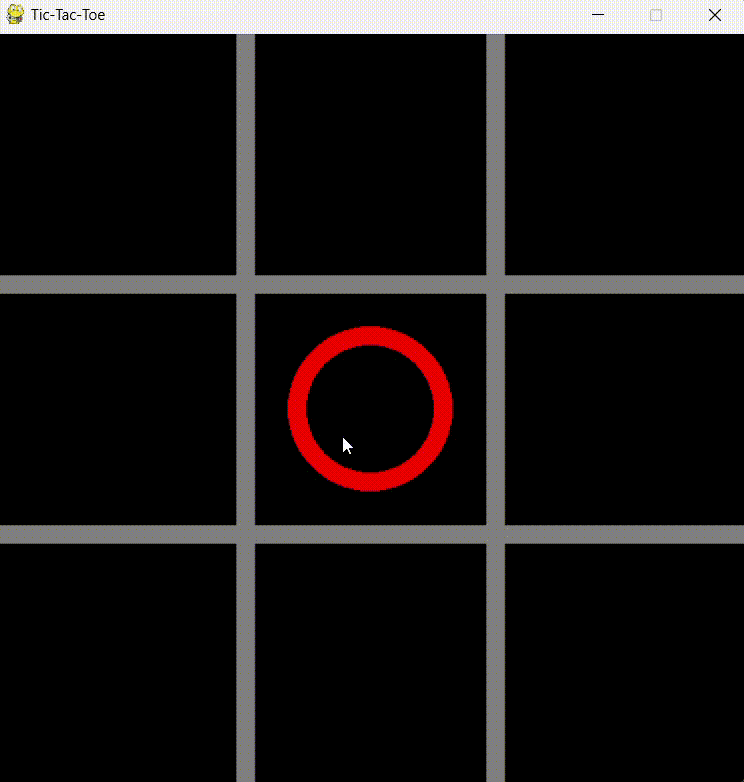Tic-Tac-Toe is a simple yet exciting game that many of us grew up playing. In this guide, you will learn how to build your own Tic-Tac-Toe game using Python and the popular Pygame library. This project is perfect for beginners who want to get started with game development using Python.

Why Do We Use the Pygame Library?
Pygame makes it super simple to create games with Python. It handles all the tricky stuff, like graphics, user input, and game mechanics, so you can focus on the fun part—building the game. Plus, it’s a great starting point if you’re new to game development.
What You’ll Learn from This Python Tic-Tac-Toe Tutorial
Here’s what we’ll cover in this project:
- Creating a Tic-Tac-Toe game board
- Handling player turns and input
- Detecting wins and draws
- Adding a restart option for endless fun
Installing Pygame
Before jumping in, you’ll need to install Pygame. If you haven’t done that yet, run this command:
pip install pygameSource Code for Creating Tic-Tac-Toe game in Python
import pygame
import sys
# Initialize pygame
pygame.init()
# Set up the display
WIDTH, HEIGHT = 600, 600
LINE_WIDTH = 15
BOARD_ROWS = 3
BOARD_COLS = 3
SQUARE_SIZE = WIDTH // BOARD_COLS
CIRCLE_RADIUS = SQUARE_SIZE // 3
CIRCLE_WIDTH = 15
CROSS_WIDTH = 25
SPACE = SQUARE_SIZE // 4
# Colors (classic theme)
BG_COLOR = (0, 0, 0) # Black background
LINE_COLOR = (128, 128, 128) # Gray lines
CIRCLE_COLOR = (255, 0, 0) # Red for circles (Player 1)
CROSS_COLOR = (0, 0, 255) # Blue for crosses (Player 2)
# Initialize board
board = [[0 for _ in range(BOARD_COLS)] for _ in range(BOARD_ROWS)]
# Set up the window
screen = pygame.display.set_mode((WIDTH, HEIGHT))
pygame.display.set_caption('Tic-Tac-Toe')
screen.fill(BG_COLOR)
# Font for text
font = pygame.font.Font(None, 50)
small_font = pygame.font.Font(None, 30)
# Draw lines
def draw_lines():
# Horizontal lines
pygame.draw.line(screen, LINE_COLOR, (0, SQUARE_SIZE), (WIDTH, SQUARE_SIZE), LINE_WIDTH)
pygame.draw.line(screen, LINE_COLOR, (0, 2 * SQUARE_SIZE), (WIDTH, 2 * SQUARE_SIZE), LINE_WIDTH)
# Vertical lines
pygame.draw.line(screen, LINE_COLOR, (SQUARE_SIZE, 0), (SQUARE_SIZE, HEIGHT), LINE_WIDTH)
pygame.draw.line(screen, LINE_COLOR, (2 * SQUARE_SIZE, 0), (2 * SQUARE_SIZE, HEIGHT), LINE_WIDTH)
draw_lines()
# Mark square on the board
def mark_square(row, col, player):
board[row][col] = player
# Check if square is available
def available_square(row, col):
return board[row][col] == 0
# Check for a win
def check_win(player):
# Check vertical, horizontal, and diagonal wins
for col in range(BOARD_COLS):
if board[0][col] == board[1][col] == board[2][col] == player:
return True
for row in range(BOARD_ROWS):
if board[row][0] == board[row][1] == board[row][2] == player:
return True
if board[0][0] == board[1][1] == board[2][2] == player:
return True
if board[2][0] == board[1][1] == board[0][2] == player:
return True
return False
# Check for a draw
def check_draw():
for row in range(BOARD_ROWS):
for col in range(BOARD_COLS):
if board[row][col] == 0:
return False
return True
# Draw figures
def draw_figures():
for row in range(BOARD_ROWS):
for col in range(BOARD_COLS):
if board[row][col] == 1:
pygame.draw.circle(screen, CIRCLE_COLOR, (int(col * SQUARE_SIZE + SQUARE_SIZE // 2), int(row * SQUARE_SIZE + SQUARE_SIZE // 2)), CIRCLE_RADIUS, CIRCLE_WIDTH)
elif board[row][col] == 2:
pygame.draw.line(screen, CROSS_COLOR,
(col * SQUARE_SIZE + SPACE, row * SQUARE_SIZE + SQUARE_SIZE - SPACE),
(col * SQUARE_SIZE + SQUARE_SIZE - SPACE, row * SQUARE_SIZE + SPACE), CROSS_WIDTH)
pygame.draw.line(screen, CROSS_COLOR,
(col * SQUARE_SIZE + SPACE, row * SQUARE_SIZE + SPACE),
(col * SQUARE_SIZE + SQUARE_SIZE - SPACE, row * SQUARE_SIZE + SQUARE_SIZE - SPACE), CROSS_WIDTH)
# Display message (win, draw, restart)
def display_message(text):
text_surface = font.render(text, True, (255, 255, 255)) # White text for result
text_rect = text_surface.get_rect(center=(WIDTH // 2, HEIGHT // 2))
screen.fill(BG_COLOR)
screen.blit(text_surface, text_rect)
# Show restart instruction
restart_text = small_font.render('Press Ctrl + R to restart', True, (255, 255, 255))
restart_rect = restart_text.get_rect(center=(WIDTH // 2, HEIGHT // 2 + 50))
screen.blit(restart_text, restart_rect)
pygame.display.update()
# Restart the game
def restart_game():
global board, game_over, player
board = [[0 for _ in range(BOARD_COLS)] for _ in range(BOARD_ROWS)]
game_over = False
player = 1
screen.fill(BG_COLOR)
draw_lines()
# Main game loop
player = 1
game_over = False
while True:
for event in pygame.event.get():
if event.type == pygame.QUIT:
pygame.quit()
sys.exit()
if event.type == pygame.MOUSEBUTTONDOWN and not game_over:
mouseX = event.pos[0] # X coordinate
mouseY = event.pos[1] # Y coordinate
clicked_row = mouseY // SQUARE_SIZE
clicked_col = mouseX // SQUARE_SIZE
if available_square(clicked_row, clicked_col):
mark_square(clicked_row, clicked_col, player)
draw_figures()
if check_win(player):
game_over = True
display_message(f'Player {player} wins!')
elif check_draw():
game_over = True
display_message('It\'s a Draw!')
player = 2 if player == 1 else 1
# Restart the game if Ctrl + R is pressed
if event.type == pygame.KEYDOWN and event.mod & pygame.KMOD_CTRL:
if event.key == pygame.K_r and game_over:
restart_game()
pygame.display.update()Output

Understanding the Code
Let’s take a quick look at what’s happening in the game:
- Creating the Game Board: We draw a simple 3×3 grid using gray lines on a black background for that classic feel.
- Player Turns and Input: Player 1 uses a red circle, and Player 2 uses a blue cross. You take turns clicking on the grid to place your symbol.
- Winning and Draws in Python Tic-Tac-Toe: After each move, the game checks if someone has won or if it’s a draw.
- Restarting the Game: Finished a game? No worries—just hit Ctrl + R to start a new round.
Conclusion
And you’re done! You’ve just built your own Tic-Tac-Toe game using Python and Pygame. Now that you’ve got the basics, feel free to tweak the code and make it your own. If you’re interested in more Python projects, click here. Thanks for reading, and I’ll see you in the next article!






